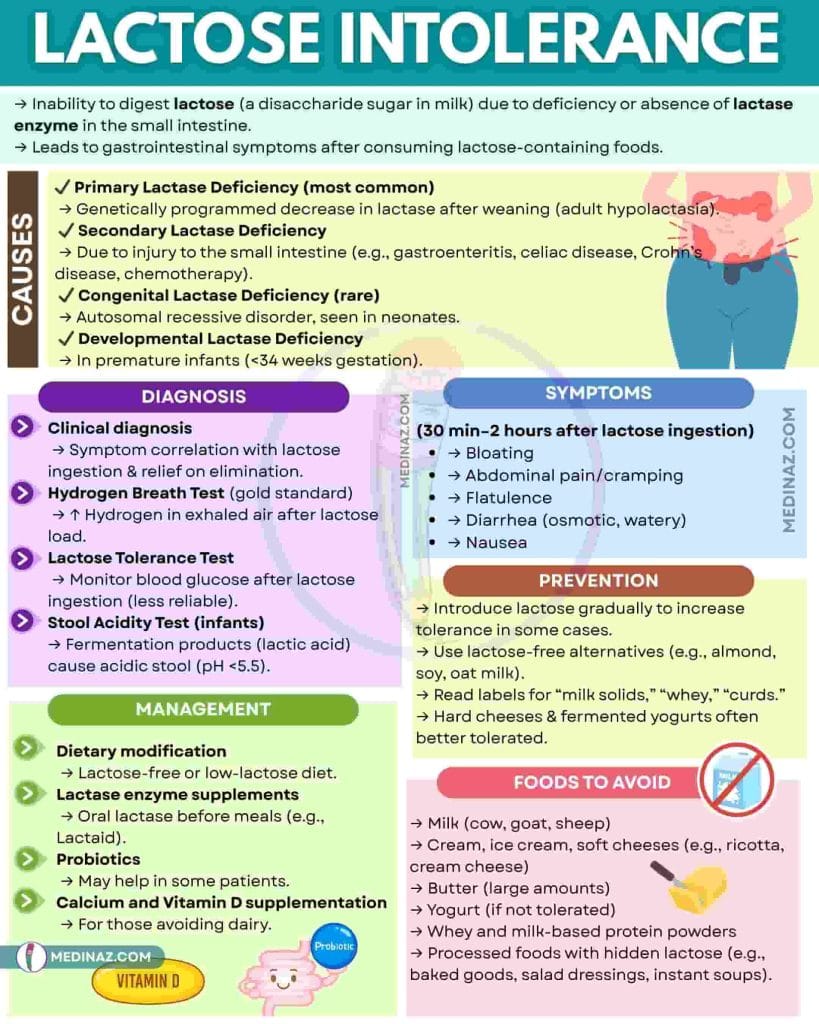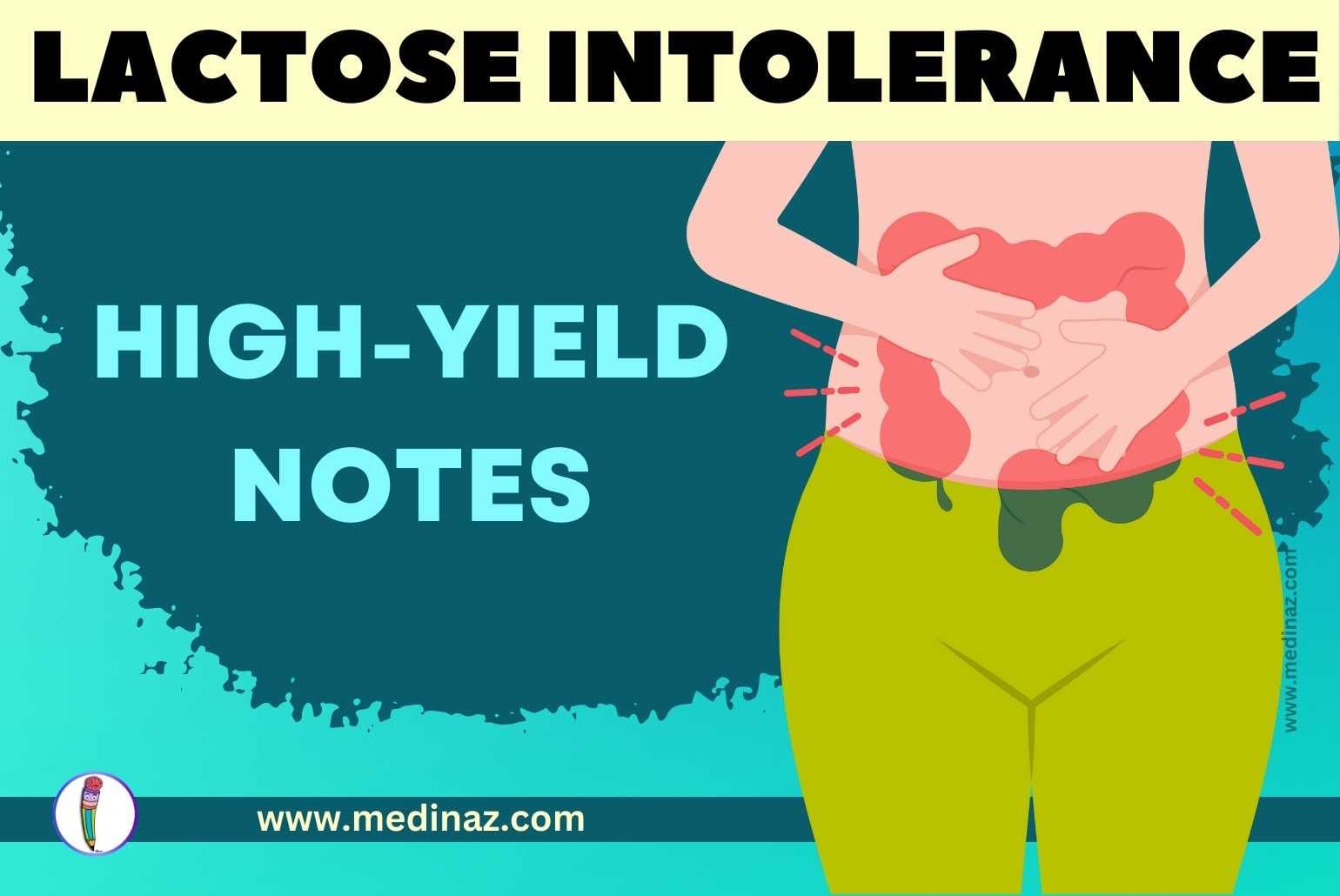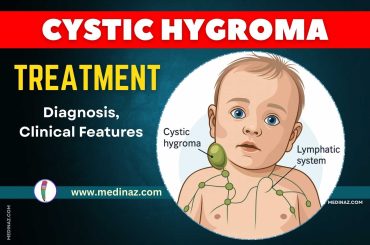Lactose Intolerance – High-Yield Notes
🔹 Definition
→ Inability to digest lactose (a disaccharide sugar in milk) due to deficiency or absence of lactase enzyme in the small intestine.
→ Leads to gastrointestinal symptoms after consuming lactose-containing foods.

Check Medinaz Book section for Highyield Visual Books
🔹 Causes
✔️ Primary Lactase Deficiency (most common)
→ Genetically programmed decrease in lactase after weaning (adult hypolactasia).
✔️ Secondary Lactase Deficiency
→ Due to injury to the small intestine (e.g., gastroenteritis, celiac disease, Crohn’s disease, chemotherapy).
✔️ Congenital Lactase Deficiency (rare)
→ Autosomal recessive disorder, seen in neonates.
✔️ Developmental Lactase Deficiency
→ In premature infants (<34 weeks gestation).
🔹 Symptoms (30 min–2 hours after lactose ingestion)
→ Bloating
→ Abdominal pain/cramping
→ Flatulence
→ Diarrhea (osmotic, watery)
→ Nausea
🔹 Diagnosis
✔️ Clinical diagnosis
→ Symptom correlation with lactose ingestion & relief on elimination.
✔️ Hydrogen Breath Test (gold standard)
→ ↑ Hydrogen in exhaled air after lactose load.
✔️ Lactose Tolerance Test
→ Monitor blood glucose after lactose ingestion (less reliable).
✔️ Stool Acidity Test (infants)
→ Fermentation products (lactic acid) cause acidic stool (pH <5.5).
🔹 Management
✔️ Dietary modification
→ Lactose-free or low-lactose diet.
✔️ Lactase enzyme supplements
→ Oral lactase before meals (e.g., Lactaid).
✔️ Probiotics
→ May help in some patients.
✔️ Calcium and Vitamin D supplementation
→ For those avoiding dairy.
🔹 Foods to Avoid
→ Milk (cow, goat, sheep)
→ Cream, ice cream, soft cheeses (e.g., ricotta, cream cheese)
→ Butter (large amounts)
→ Yogurt (if not tolerated)
→ Whey and milk-based protein powders
→ Processed foods with hidden lactose (e.g., baked goods, salad dressings, instant soups).
🔹 Prevention & Patient Education
→ Introduce lactose gradually to increase tolerance in some cases.
→ Use lactose-free alternatives (e.g., almond, soy, oat milk).
→ Read labels for “milk solids,” “whey,” “curds.”
→ Hard cheeses & fermented yogurts often better tolerated.
⭐ Key Takeaway
Lactose intolerance is common, especially in non-European populations. Diagnosis is clinical and supported by breath test. Management focuses on dietary changes and enzyme replacement.
1. What is lactose intolerance?
✅ Answer: Lactose intolerance is the inability to digest lactose, a sugar found in milk and dairy products, due to a deficiency of the enzyme lactase in the small intestine. It causes gastrointestinal symptoms after consuming lactose-containing foods.
2. What causes lactose intolerance?
✅ Answer: The main causes are:
- Primary lactase deficiency (most common): genetic reduction in lactase after childhood.
- Secondary lactase deficiency: due to intestinal damage (e.g., gastroenteritis, celiac disease).
- Congenital lactase deficiency (rare): present from birth.
- Developmental lactase deficiency: in premature infants.
3. What are the symptoms of lactose intolerance?
✅ Answer: Symptoms appear 30 min to 2 hours after consuming lactose and include:
→ Bloating
→ Abdominal cramps
→ Diarrhea (watery)
→ Flatulence (gas)
→ Nausea
4. How is lactose intolerance diagnosed?
✅ Answer:
- Clinical diagnosis: based on symptoms after lactose ingestion and improvement after avoiding lactose.
- Hydrogen breath test (gold standard): detects hydrogen in breath after lactose load.
- Lactose tolerance test: checks blood glucose rise after lactose ingestion.
- Stool acidity test: used in infants.
5. Can lactose intolerance be cured?
✅ Answer: No, there’s no cure. But symptoms can be controlled by avoiding lactose, using lactase supplements, and trying lactose-free alternatives.
6. What foods should people with lactose intolerance avoid?
✅ Answer: Avoid or limit:
→ Milk (cow, goat, sheep)
→ Cream, ice cream, butter (large amounts)
→ Soft cheeses (ricotta, cream cheese)
→ Whey and milk-based products
→ Processed foods with hidden lactose (check labels).
7. Are there any lactose-free dairy options?
✅ Answer: Yes! You can try:
→ Lactose-free milk and dairy products
→ Plant-based milk (almond, soy, oat, coconut)
→ Hard cheeses (cheddar, parmesan) which are naturally low in lactose
→ Fermented yogurt (better tolerated by some people).
8. Why is calcium important for lactose-intolerant people?
✅ Answer: Since they avoid dairy (a major calcium source), they are at risk for calcium and vitamin D deficiency. Supplements or calcium-rich alternatives (tofu, spinach, fortified plant milk) are recommended.
9. Can probiotics help with lactose intolerance?
✅ Answer: Yes, some probiotics (especially those containing Lactobacillus and Bifidobacterium) may improve digestion of lactose and reduce symptoms in some individuals.
10. How can lactose intolerance be prevented or managed in daily life?
✅ Answer:
- Gradually reintroduce small amounts of lactose to build tolerance.
- Use lactase enzyme tablets before meals.
- Choose lactose-free alternatives and read food labels carefully.
- Plan meals to ensure adequate calcium and vitamin D intake.
A Visual Learning Platform





